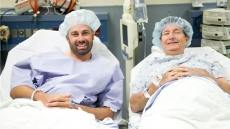LONDON — Britain's House of Commons gave preliminary approval Tuesday to permitting scientists to create babies from the DNA of three people, a technique that could protect some children from inheriting potentially fatal diseases from their mothers.
The bill must still needs approval by the House of Lords — and a further Commons vote on any amendments — before becoming law. If so, it would make Britain the first nation to allow embryos to be genetically modified.
Britain has long been a leader in reproductive technology; the world's first baby from in vitro fertilization, Louise Brown, was born in the U.K. in 1978.
The vote in the House of Commons was 382-128 in favour. No date has been set for debate in the House of Lords but it is expected to be in the next few weeks. It would be unusual for it to reject legislation that has passed overwhelmingly in the Commons.
The contentious techniques — which aim to prevent mothers from passing on inherited diseases — involve altering a human egg or embryo before transferring it into the mother. Critics fear these techniques could lead to the creation of "designer babies."
Defects in the mitochondria can result in diseases including muscular dystrophy, heart, kidney and liver failure and severe muscle weakness.
The technology is completely different from that used to create genetically modified foods, where scientists typically select individual genes to be transferred from one organism into another.
In the House of Commons, Health Minister Jane Ellison said the legislation was "a bold step to take, but it is a considered and informed step."
Some say the techniques cross a fundamental scientific boundary, since the changes made to the embryos will be passed on to future generations.
"(This is) about protecting children from the severe health risks of these unnecessary techniques and protecting everyone from the eugenic designer-baby future that will follow from this," said David King, director of the secular watchdog group Human Genetics Alert.
The techniques would likely be used only in about a dozen British women every year who have faulty mitochondria, the energy-producing structures outside a cell's nucleus, according to Britain's Department of Health.
The technique involves removing the nucleus DNA from the egg of a prospective mother and inserting it into a donor egg from which the nucleus DNA has been removed. This can be done before or after fertilization.
The resulting embryo would have the nucleus DNA from its parents but the mitochondrial DNA from the donor. Scientists say the DNA from the donor egg amounts to less than 1 per cent of the resulting embryo's genes.
Last year, the U.S. Food and Drug Administration held a meeting to discuss the techniques and scientists warned it could take decades to determine if they are safe. Experts say the techniques are likely being used elsewhere, such as in China and Japan, but are mostly unregulated.
Rachel Kean, whose aunt suffered from mitochondrial disease and had several miscarriages and stillbirths, said she hoped British politicians would approve the techniques. Kean, an activist for the Muscular Dystrophy Campaign, said her mother is also a carrier of mitochondrial disease.
"Knowing that you could bring a child into this world for a short, painful life of suffering is not something I would want to do," she said.
A spokesman for Prime Minister David Cameron said he was a "strong supporter" of the change. Cameron had a severely disabled son, Ivan, who died at age 6 in 2009, from a rare form of epilepsy.
Lisa Jardine, who chaired a review into the techniques conducted by Britain's fertility regulator, said each case would be under close scrutiny and that doctors would track children born using this technique and their future offspring.
"Every medical procedure ultimately carries a small risk," Jardine said, pointing out that the first baby created using in-vitro fertilization was the product of an experiment with unproven methods.
Kean said she understood the opposition to the new technology.
"It's everybody's prerogative to object, due to their own personal beliefs," she said. "But to me the most ethical option is stopping these devastating diseases from causing suffering in the future."
The UK's proposal to make babies from 3 people: the science, the logistics and the controversy
Tue, 03 Feb 2015 12:58:23 -0500
Here are some questions and answers about the proposed techniques and the controversy surrounding them.
WHY ARE SCIENTISTS PROPOSING THIS?
The new fertility techniques aim to help women who are carriers of mitochondrial disease from passing it on to their children. Mitochondria are the energy-producing structures outside of a cell's nucleus, and defects in them can result in degenerative diseases including muscular dystrophy, problems with the heart and kidneys, severe muscle weakness, epilepsy and mental retardation.
Scientists would remove the nucleus DNA from the egg of a prospective mother and insert it into a donor egg from which the nucleus DNA has been removed. That can be done either before or after fertilization. The resulting embryo has nucleus DNA from its parents but mitochondrial DNA from the donor. Scientists say the DNA from the donor egg is less than 1 per cent of the resulting embryo's genes.
WHO IS OPPOSED TO THIS?
The Catholic Church has long opposed any artificial reproductive techniques that include fertilization or the destruction of embryos. Last week, the Church of England voiced concern that there had not been enough scientific study or consultation of the techniques. Other critics say that because the genetic change made to the embryo or egg will be a permanent one that is passed on, it's impossible to know what impact they will have on future generations and if there are any safety problems.
IS THIS LIKE MAKING GENETICALLY MODIFIED FOODS?
No. To make genetically modified foods, scientists select individual genes to be transferred from one organism into another. Most of the genetically modified foods on the market are aimed at making crops less vulnerable to pesticides or plant diseases.
In the techniques used to help women with mitochondrial disease, no genes are inserted into the egg or the embryo.
HOW WIDELY WOULD THE MITOCHONDRIAL TECHNIQUES BE USED?
Experts estimate only about a dozen British women would be considered for this every year and that some women may choose other ways to have children, such as egg donation or adoption. Clinics that offer the techniques will have to apply for a special license and any children born afterward will be closely monitored for potential health problems. Experts estimate the first baby born from these techniques could come within the next three years.
IS THIS ALLOWED ANYWHERE ELSE?
Not legally. There are no mitochondria replacement treatments approved by the U.S. Food and Drug Administration. Last year, the U.S. agency met to discuss the techniques proposed in the U.K. Scientists in the U.S. said it's too soon to use them in humans, although monkeys have been produced using one of the techniques.





